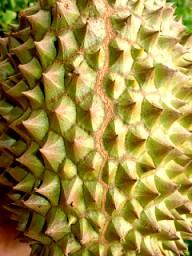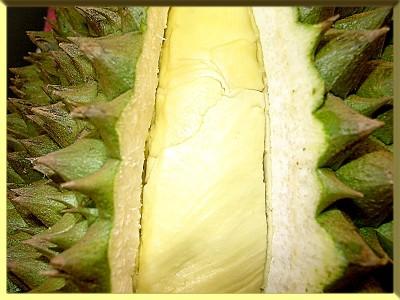How to eat fresh Durian
Eating durian correctly makes a big difference.
As a durian approaches ripeness, the tough rind with its previously intimidating thorny spikes will now naturally, easily, and graciously unzip along hidden suture lines between the inner sections (or locules). Looking at a durian that has not naturally begun to split open, it can be puzzling to guess where these lines actually might be, zigzagging among the spikes—and surprising to find out where they actually are. Left to itself, as ripeness progresses, the a durian naturally starts cracking open from the bottom end, revealing and offering its inner fruit bounty to creatures large and small.
Selecting a durian
 The zigzag line where a durian will naturally split apart between sections is not always so evident as this
The zigzag line where a durian will naturally split apart between sections is not always so evident as this
Malaysian durians (and other similar Southeast Asian varieties that are closer to the wild) are always allowed to naturally ripen and drop from the tree. They are always considered a little past their prime if they have any crack showing at all.
Thai varieties of durians are a different story; they are always cut from the tree while still green and allowed to ripen off the tree. (A Thai durian allowed to drop naturally from the tree is probably already past its prime).
In my early experiences with Thai durians, I would look for the first slight sign of a crack along one of these lines at the bottom of the fruit, as an indication of ripeness.
My inclination was to wait for the fruit to give a natural sign that it’s ready for eaters by making it easy to enter. I still tend to think that if you have to engage in a difficult wrestling or knifing match with a durian to get in, it’s too early. However, as I gained more experience, I discovered that Thai durians opened earlier than that (possible only with a knife), before any natural crack appeared, were usually more exquisite than the naturally-cracked fruits.

Early-ripe Thai durians like this usually have a bright freshness, more of a flavor complexity, and an intriguing and tasty succulent-crunchy component surrounding the custardy part, all of which is gone from the very creamy completely-ripe pulp. This cutting into durians, though, is a very tricky business (not to mention the hazard of the fruit’s sharp spikes). I have ruined more than a few Thai durians, or parts of them, that I estimated were at that special stage mentioned above, before they cracked, by cutting into them only to find that they were much too green. I’ve found that some Thai-variety durians may be at their prime when just a tiny first crack has appeared, but more often it’s a little before that.
(For another writer's perspective and experience with this, read Bill Stimson's delightful essay "Opening a Durian" here.)
In Asia, durian is said to have "heaty" properties—eating very much will give your body a heated sensation for a brief period thereafter. I have found this to be true from my own experience. It’s not necessarily unpleasant, it just happens, and is part of the overall durian-eating experience (along with classic satisfied durian-scented burps!). Durian is not recommended eating if you have a high temperature from some illness, though. It follows that durian’s heatiness contributes a subtle paradoxical appeal and delight to durian ice cream.
Durian is not recommended for consuming with alcoholic beverages, as the combination of natural substances is a powerful producer of internal gas.
Sound durian fruit will store satisfactorily in refrigeration for up to 3 weeks at 59º F. [15º C.].
Durian is not only exquisitely delicious but richly nutritious, a complete natural meal in itself high in carbohydrate, proteins, fat, minerals, and vitamins. The exact nutritional composition of a ripe durian can vary greatly, depending on soil richness, growing methods, climate conditions, and variety. The range of nutritional values for 100 grams [about 3 ½ ounces] of the fresh pulp (aril) reported from seven different sources are:
Durian Nutritional
Characteristics |
|||
| calories | 134-153 | carotene (Vit. A) | 20-30 IU |
| moisture | 58-70 g | thiamin (Vit. B1) | 0.20-0.28 mg |
| protein | 2.0-3.3 g | riboflavin (Vit. B2) | 0.10-0.28 mg |
| carbohydrates | 30.0-36.1 g | niacin | 0 .68-1.1 mg |
| fat | 1.2-4.3 g | Vitamin C | 23-62 mg |
| calcium | 7.4-18 mg | Vitamin E | "high" |
| phosphorus | 27-56 mg | trace minerals | "many" |
| iron | 0.73-2.0 mg | mana (intangible life energy) | "powerful" |
I’ve noticed that durians wrapped in a newspaper and plastic bag for awhile do emit actual heat — the fruit and wrapping and air inside all get heated up. A pity durians aren’t common in cold climates, and that their heat is wasted on tropical residents who already have a lavish abundance of it! Certain other fruits such as mangosteen and citrus are said to have "cooling" properties and are recommended as an antidote to a feeling of having eaten too much durian (and it can be hard to stop!) A different kind of remedy (from Bao Sheng Durian Farm) is to pour water into an empty durian shell, sprinkle table salt into it, mix well and drink; something in the shell walls, combined with salt, makes an effective antidote to excessive durian heatiness.
More useful eating tips from Bao Sheng Farm:
- If eating several varieties of durian at the same time, eat the best last because the best’s aroma and flavor will cover all the others, and if you eat the best first, you won’t be able to experience the others.
- If faced with the pleasant task of eating several varieties, the preferred order of eating is the more moist varieties first, ending with the more "gummy" varieties (which are regarded in Malaysia as the best). (This is more a Malaysian-style durian situation, as Thai varieties of durians are generally larger, people tend to eat only one Thai variety at a time, and there are fewer choices of variety in the marketplace.)
- To remove the odor of durian from your hands, wash your hands with durian seeds; amazing, but it works (thanks again to T.S. Chang at Bao Sheng Durian Farm in Malaysia).